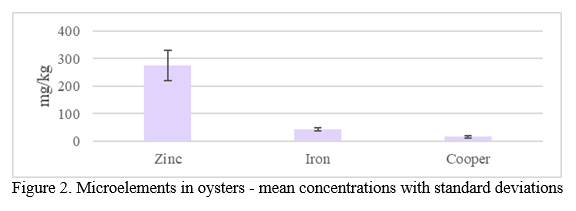MACRO- AND MICROELEMENT CONTENT IN OYSTERS Ostrea edulis L. CULTIVATED IN THE MALI STON BAY, ADRIATIC SEA
Introduction
Oysters are among the most commonly farmed marine species and are native to almost all ocean regions with the exception of the polar regions. They are prized as a delicacy and play an important role in global seafood consumption. In recent years, growing awareness of their nutritional value has led to an increase in demand, with oyster production increasing by an average of 7.8% per year over the last three decades. Compared to finfish, shellfish generally contain a higher protein content, and oysters are no exception. They are also rich in macroelements (Na, K, Ca, P and Mg) and trace elements (Cr, Co, Cu, F, Br, I, Fe, Se, Zn and Mn), some of which, such as iron, copper and zinc, play a crucial role in various biological systems. The aim of this study was to investigate the seasonal variations in the mineral composition of shallow oysters (Ostrea edulis L.) from the Bay of Mali Ston in the Adriatic Sea.
Materials and methods
Samples were taken each month over a seven-month period and analyzed by flame atomic absorption spectroscopy (200 Series A4 with SPS 4 Auto-Sampler, Agilent Technologies, USA) to determine the content of selected macro- and micro- elements.
Results
The results show that the macroelements (Figure 1) exhibit greater seasonal fluctuations, while the microelements (Figure 2) remain relatively constant. The average content of minerals in all samples was as follows: 6011 mg/kg for Na, 2613 mg/kg for Ca, 3533 mg/kg for K, 858 mg/kg for Mg, 275 mg/kg for Zn, 44 mg/kg for Fe, 17 mg/kg for Cu and 1586 mg/kg for P. Although specific fluctuations were observed in individual months, the overall constancy of the microelements indicates consistency in mineral content despite environmental changes.

